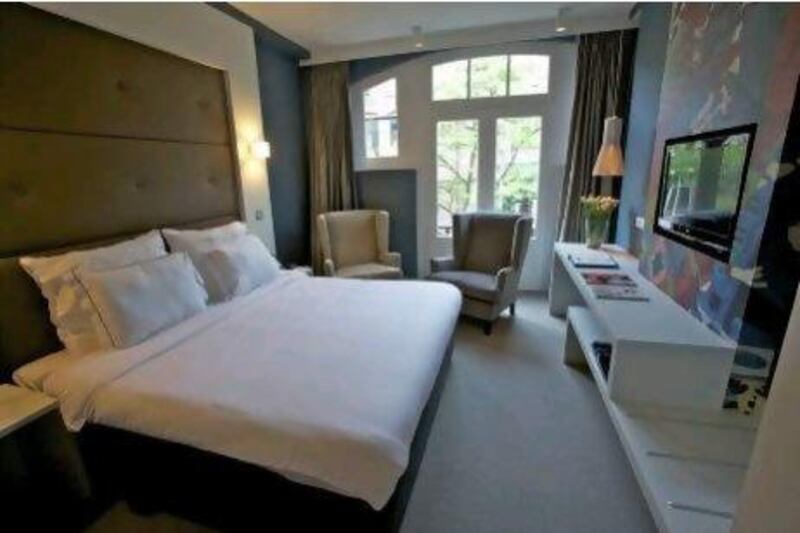It is late afternoon on the Prinsengracht canal in Amsterdam on a sunny summer's day. Handsome locals are cycling two-abreast along the narrow cobbled roads adjacent to the water, under the lime and plane trees and up and over the gently arching bridges.
Dogs are sleeping on the roofs of canal boats, at peace in the warm sun and temporarily untroubled by cats. Tourist boats cruise down the canal, pausing to point out black-painted brick buildings of interest.
Seduced by this contented scene it is hard to believe that there is a flurry of activity going on around almost every corner as the city is being flooded with smart, chic and individually designed hotels. Barely a month has gone by in the past year and a half without a new hotel opening or an old one announcing the completion of a major refurbishment.
The authorities are responding to a desperate need for several thousand new 3-, 4- and 5-star hotel rooms to compete with other European capitals. The dearth of beds has not helped Amsterdam to capitalise on the treasures that make it famous, notably its significant art collections, its romantic canals and its wonderfully preserved architecture, some of which became a Unesco World Heritage Site in 2010.
According to René van Schie, hotel development intermediary in the City of Amsterdam's Economic Development Department, demand for hotel rooms had for years outstripped supply. "Many tourists could not book the rooms they wanted and conference organisers were not able to reserve their required blocks of rooms," he says. "This meant we were running at the very high average occupancy rate of 82 per cent which drives up prices and is not a stimulant for quality improvement."
And this at a time when other European capitals were spending big on über-chic new properties and lavish refurbishments of glamorous grandes dames.
Amsterdam has had to catch up and fast. The city has so far created 4,000 new hotel rooms, roughly half the number it plans to build by 2015. Crucially, a disproportionately large number of the new properties are not chain hotels, a huge shift for a city which until now which has been dominated by the big global brands.
The city still needs those existing chain hotels but, as van Schie points out: "Now we are offering visitors something else as well, something Amsterdam has really not focused on in the past - the more personal, individually designed boutique hotel; very stylish, very Dutch and very chic."
JL No.76is a good example of this trend. It is a 39-room hotel down the road from the Rijksmuseum and around the corner from PC Hooftstraat and Cornelis Schuytstraat, the former packed with high-end designer stores and the latter with lesser-known boho labels and cosy brasseries.
The hotel has a homely feel with rooms overlooking the quiet street or the gardens behind, and a central lounge where guests are encouraged to use an honesty bar for everything from a caffe latte to a cocktail.
The hotel's owner, Arjen van den Hof, has indulged his love of art to pepper the property with modern works from both famous and aspiring Dutch painters. Textile artist Barbara Broekman was commissioned to design a unique piece of wallpaper for each room based on originally embroidered artworks.
JL No.76 is the newest of four Vondel Hotel properties (three hotels and a 'bed and no breakfast' - 'b&nb'), each of which has taken over a historic building and transformed it into a modern property with an individual concept.
A second good example of the hotel revolution is just over the road from JL No.76. It is a large sandstone building which is now home to the Conservatorium Hotel Amsterdam, named after the Sweenlinck Conservatorium of Music, a previous tenant of the building.
Of the 129 rooms, around 40 per cent are loft-style duplexes with great views over the city's rooftops. The emphasis is on wellness, with a comprehensive 1,000 sqm Akasha Holistic Wellbeing Retreat which has four areas corresponding to the elements earth, fire, air and water. The hotel sports a large central atrium with a library and even a small wood where trees are planted in the basement so the treetops will emerge at ground level.
Such individuality in design would have been virtually impossible before Amsterdam's hotel revolution. So, presumably, would the idea of a "fashion hotel" in which rooms are "dressed like models", each one individually designed by students at the Amsterdam Fashion Institute, and yet here it comes in the shape of Hotel the Exchange which opened late last year.
The tongue-twisting Inntel Hotel Amsterdam Zaandam was another ambitious 2011 launch, at least architecturally, as it was designed to look like several traditional Dutch houses piled on top of one another. Even two of the more stately properties, the Dylan and the Hotel de l'Europe, have taken walks on the creative side. The former added 10 individually designed rooms in the past two years, including the Dylan Thomas Suite which boasts Chinese teak cabinets, and a coffee table and lamp bases made from what at first appears to be marble but is in fact ancient petrified wood. The Hotel de l'Europe re-opened in spring 2011 after a renovation to add its new Dutch Masters Wing, which includes 23 suites, each of which sports a replica of a painting hanging in the Rijksmuseum.
It is thrilling to admire the new properties and their bursts of individual design, but there is one that stands head and shoulders above the rest and is the perfect example of the new mature, confident and daring Amsterdam: the Canal House, which opened on June 14, 2011.
It has 23 exquisite rooms, immaculately designed within the superstructure of two 17th century merchants' houses, right on the Keizersgracht canal in the Jordaan district. The designers have cleverly replicated the dark colours of classic Dutch paintings throughout the public areas of the hotel. The walls of the bar are coal black, the carpet a deep purple; the dining room is also predominantly inky with black furniture from modern Dutch design house Moooi. The darkness is offset and prevented from becoming full-on Gothic with gold picture frames which surround mirrors not paintings, by warm and soft lighting and by lovingly restored original ceilings. Large, tall windows fill the place with natural light and allow guests to gaze out onto the canal at the front and the substantial garden at the back.
A quirk is that the architecture of the former residence requires most guests to traverse a corner of the kitchen to access their rooms. They become, momentarily, part of the workings of the hotel but as the kitchen is blessed with a delightful staff and the glorious scents of fresh North Sea plaice and roast lamb, this is far more a benefit than a hindrance. If you're in luck you can chat to the chef about his commitment to buy only locally grown produce and his passion for "lost" herbs and vegetables which he is rediscovering and introducing to this menu.
The rooms themselves are inviting, cosy and downright sexy: dark purple walls, dark brown leather sofas, bathrooms mosaic-ed with blood-red and gold tiles, and striking photographs adorning the walls, specially commissioned from artists such as Marcel Wanders.
Most bathrooms are termed "open-plan" and not separated from the rest of the room; not everyone's cup of tea but they match the edgy, avant garde philosophy of the place. The natural Green & Spring soap, shampoo and moisturiser (made in the English county of Gloucestershire especially for the hotel and its two sister properties) provide the icing on the cake.
The designers clearly thought long and hard about the most suitable theme for the hotel and they have remained true to it throughout. As a result, the Canal House is elegant, intimate, fun and just slightly mysterious - just like Amsterdam.
If You Go
The flight Return flights to Amsterdam from Dubai with Emirates (www.emirates.com) cost from Dh3,830, including taxes
The hotels JL No.76 (www.vondelhotels.com; 00 31 20 515 0453) has standard rooms from €95 (Dh461). Inntel Hotel Amsterdam Zaandam (www.inntelhotelsamsterdamzaandam.nl; 00 31 75 631 1711) has standard rooms from €90 (Dh437) per night. The Dylan (www.dylanamsterdam.com; 00 31 20 530 2010) has double rooms from €288 (Dh1,385), including breakfast. Hotel de l'Europe (www.leurope.nl; 00 31 20 531 1777) has double rooms from €285 (Dh1,385) per night, including breakfast. Canal House (www.canalhouse.nl; 00 31 20 622 51 82) has good rooms from €240 (Dh1166) per night. Prices include taxes





